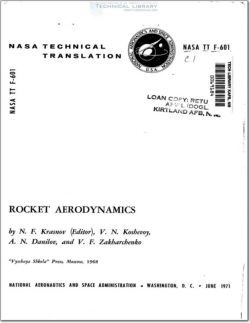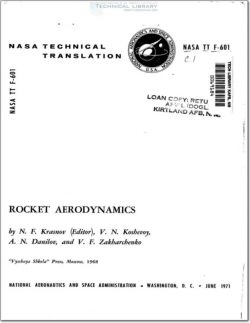NASA-TT-F-601

- Version
- 415 Downloads
- 62.25 MB File Size
- 1 File Count
- August 18, 2016 Create Date
- August 18, 2016 Last Updated
Rocket Aerodynamics

Modern aerodynamics is developing in tw0 basic directions,
one of which is concerned with further development and improve-
ment of methods for determining the forces exerted by a medium
on a body moving in it, and the other with the investigation and
calculation of thermal processes on the walls of the vehicle,
which are accompanied by various physicochemical transformations.
The second trend has become an independent division of the aero—
dynamic sciences — aerothermodynamics. Aerothermodynamic re-
search isadvancingfbr the most part independently, using data
from conventional ("force") aerodynamics. In recent years, as
the mathematical apparatus has been perfected, more and more of
the aerodynamic problems associated with determination of the
force effects and heat transfer are being solved jointly. In
many cases, however, it is practically justifiable to assume
that the force and thermal processes are independent of one an-
other and to compute them separately. Accordingly, the distribu—
tion of gas variables in flow over a surface (pressure, fric—
tion stress, temperature, etc.) is found without consideration
of heat transfer at the wall. Heat flows, on the other hand, can
be calculated separately using these variables.
The distributions of pressure, temperature, and density (the
so—called "inviscid" variables) are studied by solving the cor-
responding gasdynamic equations for an inviscid (ideal) gas. The
resulting "inviscid" variables are used to solve the boundary—
layer equations and compute the distribution of tangential
[shearing] stresses over the surface of the vehicle.
When the vehicles move at very high speeds, the air near the
surface of the body is heated to very high temperatures, at which
chemical reactions take-place. Consideration of the effect of
these reactions on the magnitude and distribution of pressure,
temperature, and other variables is a salient feature of modern
‘aerodynamics that has been treated in the present volume.
The book devotes considerable space to study of nonsteady
flow past bodies of various shapes, which is currently of major
importance.
| File | Action |
|---|---|
| NASA-TT-F-601 Rocket Aerodynamics.pdf | Download |
Comment On This Post